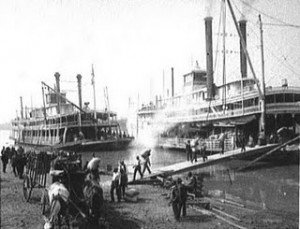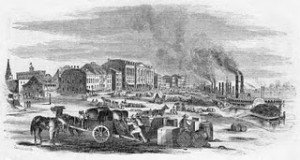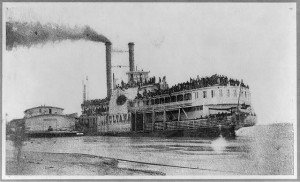The history of steamboats is fascinating. Steamboats helped America expand westward. It was able to travel where there were no roads. It carried people and needed supplies to hard to reach places. During the mid 1800’s, this remarkable invention in transportation had only one problem, and it was a big problem. It’s boilers could and would explode. The boilers that powered the steam boat engine were a huge concern. The explosion of the steamboat Pennsylvania on June 13, 1858 is very representative of the dangers river travelers faced during the period. Steam boat history is filled with stories like it.
 During this era steam boilers the size required to run a steamboat were a relatively new creation. Pressure instruments were not what they are today and the strength needed in the materials used in boiler construction was a bit sketchy. This required that the boilers be physically monitored. Simply put, if too much pressure were allowed to build up, the boiler might explode.
During this era steam boilers the size required to run a steamboat were a relatively new creation. Pressure instruments were not what they are today and the strength needed in the materials used in boiler construction was a bit sketchy. This required that the boilers be physically monitored. Simply put, if too much pressure were allowed to build up, the boiler might explode.
And explode they did and with great numbers of people lost. In the case of steamboats, boilers naturally were placed down within the infrastructure of the boat. Explosions therefore had a catastrophic effect occurring deep inside a wooden vessel. Steamboats would literally blow apart in a ball of fire and hot steam. In many cases, those who didn’t die during the explosion itself often drowned after jumping or being thrown into the water. The huge loss of life was even more significant when you consider how much smaller the general population was in the mid 1800’s.
Steamboat mishap statistics during the mid 1800’s tells quite a story. During the years 1838 and 1870 a total of 2,200 people were killed.and hundreds injured. The largest explosion ever recorded was that of the SS Sultana just north of Memphis Tennessee in April 1865 with an estimated 1,800+ loss of life. The Sultana was grossly overloaded with returning Union soldiers from the recently ended American Civil War, most of whom spent the past few years in Confederate POW camps including the infamous Andersonville Prison. The Sultana was supposed to be their ticket home after the war. In addition to these statistics concerning steamboats, there were 111 deaths attributed to industrial boiler explosions during the period. A picture of the Sultana in early 1865 just prior to the explosion is shown below right.
The tragic explosion of the SS Pennsylvania was not only a disaster for the nation but was a personal disaster for the ex-steamboat pilot Mark Twain. It so happened that Mark Twain, who was quite fond of steamboats, was working as a steersman on the SS Pennsylvania up until a few days before the explosion. He had personal differences with the boat’s master and resigned, but not before getting his brother a job on the vessel. Samuel Clemens (Mark Twain’s) brother was killed during the riverboat disaster. Understandably, Clemens was haunted with this reminder the rest of his life.
 Concerning the boiler explosion itself, it seems that the SS Pennsylvania engineer tasked with keeping an eye on the boilers steam pressure was aft, away from his post, speaking with female passengers.
Concerning the boiler explosion itself, it seems that the SS Pennsylvania engineer tasked with keeping an eye on the boilers steam pressure was aft, away from his post, speaking with female passengers.
According to the New York newspapers at the time, an eyewitness gave court testimony to the fact that the engineer was not at his post in the engine room just prior to the explosion and was seen with the women. All four of the boilers exploded while the SS Pennsylvania was about 75 miles below Memphis Tennessee on the Mississippi River and about 300 yards from shore. It was estimated that the entire structure of the boat was in flames only about a minute after the explosion. The SS Pennsylvania left New-Orleans on the ninth of the month with one hundred and twenty-five cabin passengers and one hundred and fifty-eight crew. With stops on the way up the river at Baton Rouge, Natchez and Vicksburg, there were a total of about 450 people in all.
Out of this number, 182 were rescued by a another boat, and about 70 others escaped. These numbers included the wounded and burned. About 200 were estimated lost and missing. The wreck of the SS Pennsylvania floated about two miles down river and burned all the way to the water line.
 The SS Pennsylvania explosion unfortunately was one of many during the 1800’s. The federal government was pressured to do something to safeguard the traveling public and as a result passed several maritime bills. The bills tried to set certain requirements and training standards and to some degree they helped but certainly didn’t rectify the problem. Compounding the problem of faulty equipment and poor monitoring was the habit of steamboats trying to make speed records on their runs and in some cases racing. This just overtaxed the boilers and was the cause of more than one disaster. The boilers could be unpredictable as in the case of the Saluda explosion just off the docks at Lexington Missouri on April 9, 1852. The Missouri River was swollen from spring rains and snow melt and the captain was determined to make it upriver around a sandbar. He had been held back by the current previously and this time was determined to make it. He called for maximum boiler pressure while leaving the dock.The resulting explosion which occurred right after the paddle wheel started to turn threw bodies all through the town of Lexington and even killed some standing on the dock.The body of the captain, last seen standing on the roof of the boat, was eventually found on the far side of a dock warehouse. The explosion was so violent that just about all of the passengers, and some bystanders, died. Out of 250+ people on board, most of them Mormons traveling to Salt Lake City, only about 40 to 50 survived. It ranked as one of the worst steamboat disasters.
The SS Pennsylvania explosion unfortunately was one of many during the 1800’s. The federal government was pressured to do something to safeguard the traveling public and as a result passed several maritime bills. The bills tried to set certain requirements and training standards and to some degree they helped but certainly didn’t rectify the problem. Compounding the problem of faulty equipment and poor monitoring was the habit of steamboats trying to make speed records on their runs and in some cases racing. This just overtaxed the boilers and was the cause of more than one disaster. The boilers could be unpredictable as in the case of the Saluda explosion just off the docks at Lexington Missouri on April 9, 1852. The Missouri River was swollen from spring rains and snow melt and the captain was determined to make it upriver around a sandbar. He had been held back by the current previously and this time was determined to make it. He called for maximum boiler pressure while leaving the dock.The resulting explosion which occurred right after the paddle wheel started to turn threw bodies all through the town of Lexington and even killed some standing on the dock.The body of the captain, last seen standing on the roof of the boat, was eventually found on the far side of a dock warehouse. The explosion was so violent that just about all of the passengers, and some bystanders, died. Out of 250+ people on board, most of them Mormons traveling to Salt Lake City, only about 40 to 50 survived. It ranked as one of the worst steamboat disasters.
Over the decades, progress was made it both safety and boiler construction. The string of federal regulations put in place continued into the 1900’s. As dangerous as steamboat travel could be, people needed the transportation especially before road improvements and before the transcontinental railroad. Probably, the area most improved by federal regulations had to do with training. This helped some in the type of people made responsible for boiler monitoring. Boiler construction materials and pressure instruments also improved over the years. What essentially was an unregulated industry became more and more regulated.
There are some interesting historic sites regarding steam boat history.
The Arabia Steamboat Museum is an excellent place to learn more about the early days of steamboats. The museum is located at 400 Grand Blvd in Kansas City Missouri. The side wheeler steamboat Arabia hit a snag in September of 1856 on the Missouri River. The boat sank and was eventually found in 1988 by researchers. The Arabia Steamboat Museum now displays a wide collection of artifacts taken from the old vessel. They have a very impressive collection. Well worth the visit when you travel to Kansas City MO.
Another very good museum is the Howard Steamboat Museum located in Jeffersonville Indiana. According to the Howard Steamboat Museum, their mission is to preserve the Howard family story, their mansion and the history of their shipyards and to foster an appreciation of the development of river steamboats and commerce along inland rivers. The Howard Shipyard was started in 1834. The museum address is 1101 E. Market Street, Jeffersonville Indiana.
(Photos in public domain)
